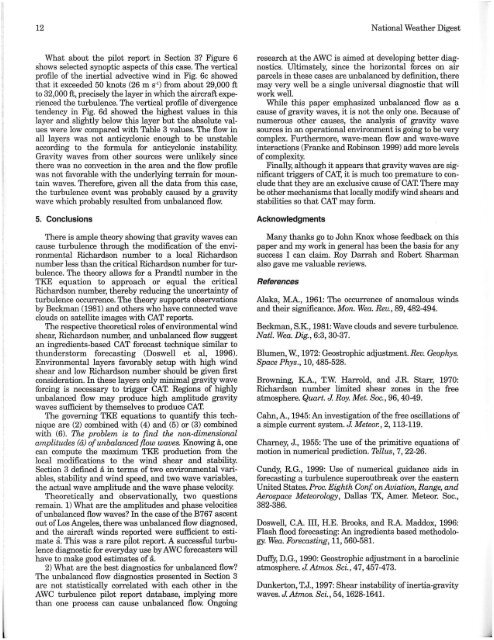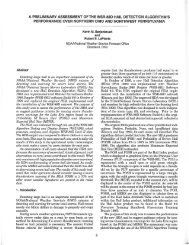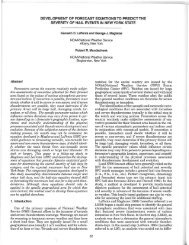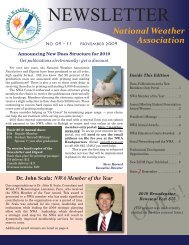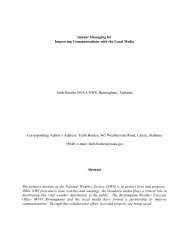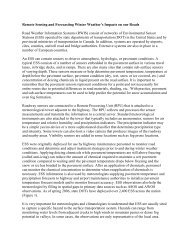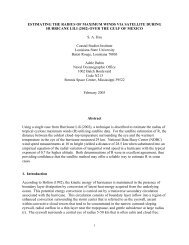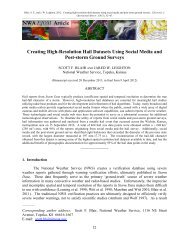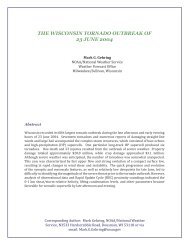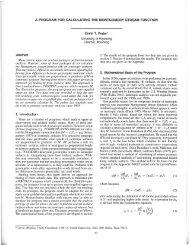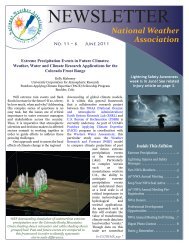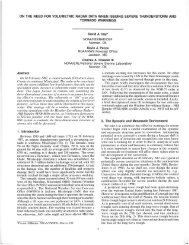gravity waves, unbalanced flow, and aircraft clear air turbulence (1)
gravity waves, unbalanced flow, and aircraft clear air turbulence (1)
gravity waves, unbalanced flow, and aircraft clear air turbulence (1)
You also want an ePaper? Increase the reach of your titles
YUMPU automatically turns print PDFs into web optimized ePapers that Google loves.
12<br />
National Weather Digest<br />
What about the pilot report in Section 3? Figure 6<br />
shows selected synoptic aspects of this case. The vertical<br />
profile of the inertial advective wind in Fig. 6c showed<br />
that it exceeded 50 knots (26 m S·l) from about 29,000 ft<br />
to 32,000 ft, precisely the layer in which the <strong><strong>air</strong>craft</strong> experienced<br />
the <strong>turbulence</strong>. The vertical profile of divergence<br />
tendency in Fig. 6d showed the highest values in this<br />
layer <strong>and</strong> slightly below this layer but the absolute values<br />
were low compared with Table 3 values. The <strong>flow</strong> in<br />
all layers was not anticyclonic enough to be unstable<br />
according to the formula for anticyclonic instability.<br />
Gravity <strong>waves</strong> from other sources were unlikely since<br />
there was no convection in the area <strong>and</strong> the <strong>flow</strong> profile<br />
was not favorable with the underlying terrain for mountain<br />
<strong>waves</strong>. Therefore, given all the data from this case,<br />
the <strong>turbulence</strong> event was probably caused by a <strong>gravity</strong><br />
wave which probably resulted from <strong>unbalanced</strong> <strong>flow</strong>.<br />
5. Conclusions<br />
There is ample theory showing that <strong>gravity</strong> <strong>waves</strong> can<br />
cause <strong>turbulence</strong> through the modification of the environmental<br />
Richardson number to a local Richardson<br />
number less than the critical Richardson number for <strong>turbulence</strong>.<br />
The theory allows for a Pr<strong>and</strong>tl number in the<br />
TKE equation to approach or equal the critical<br />
Richardson number, thereby reducing the uncertainty of<br />
<strong>turbulence</strong> occurrence. The theory supports observations<br />
by Beckman (1981) <strong>and</strong> others who have connected wave<br />
clouds on satellite images with CAT reports.<br />
The respective theoretical roles of environmental wind<br />
shear, Richardson number, <strong>and</strong> <strong>unbalanced</strong> <strong>flow</strong> suggest<br />
an ingredients-based CAT forecast technique similar to<br />
thunderstorm forecasting (Doswell et aI, 1996).<br />
Environmental layers favorably setup with high wind<br />
shear <strong>and</strong> low Richardson number should be given first<br />
consideration. In these layers only minimal <strong>gravity</strong> wave<br />
forcing is necessary to trigger CAT. Regions of highly<br />
<strong>unbalanced</strong> <strong>flow</strong> may produce high amplitude <strong>gravity</strong><br />
<strong>waves</strong> sufficient by themselves to produce CAT.<br />
The governing TKE equations to quantifY this technique<br />
are (2) combined with (4) <strong>and</strong> (5) or (3) combined<br />
with (6). The problem is to find the non-dimensional<br />
amplitudes (a) of <strong>unbalanced</strong> <strong>flow</strong> <strong>waves</strong>. Knowing a, one<br />
can compute the maximum TKE production from the<br />
local modifications to the wind shear <strong>and</strong> stability.<br />
Section 3 defined a in terms of two environmental variables,<br />
stability <strong>and</strong> wind speed, <strong>and</strong> two wave variables,<br />
the actual wave amplitude <strong>and</strong> the wave phase velocity.<br />
Theoretically <strong>and</strong> observationally, two questions<br />
remain. 1) What are the amplitudes <strong>and</strong> phase velocities<br />
of <strong>unbalanced</strong> <strong>flow</strong> <strong>waves</strong>? In the case of the B767 ascent<br />
out of Los Angeles, there was <strong>unbalanced</strong> <strong>flow</strong> diagnosed,<br />
<strong>and</strong> the <strong><strong>air</strong>craft</strong> winds reported were sufficient to estimate<br />
a. This was a rare pilot report. A successful <strong>turbulence</strong><br />
diagnostic for everyday use by AWC forecasters will<br />
have to make good estimates of a.<br />
2) What are the best diagnostics for <strong>unbalanced</strong> <strong>flow</strong>?<br />
The <strong>unbalanced</strong> <strong>flow</strong> diagnostics presented in Section 3<br />
are not statistically correlated with each other in the<br />
AWC <strong>turbulence</strong> pilot report database, implying more<br />
than one process can cause <strong>unbalanced</strong> <strong>flow</strong>. Ongoing<br />
research at the AWC is aimed at developing better diagnostics.<br />
illtimately, since the horizontal forces on <strong>air</strong><br />
parcels in these cases are <strong>unbalanced</strong> by definition, there<br />
may very well be a single universal diagnostic that will<br />
work well.<br />
While this paper emphasized <strong>unbalanced</strong> <strong>flow</strong> as a<br />
cause of <strong>gravity</strong> <strong>waves</strong>, it is not the only one. Because of<br />
numerous other causes, the analysis of <strong>gravity</strong> wave<br />
sources in an operational environment is going to be very<br />
complex. Furthermore, wave-mean <strong>flow</strong> <strong>and</strong> wave-wave<br />
interactio.ns (Franke <strong>and</strong> Robinson 1999) add more levels<br />
of complexity.<br />
Finally, although it appears that <strong>gravity</strong> <strong>waves</strong> are significant<br />
triggers of CAT, it is much too premature to conclude<br />
that they are an exclusive cause of CAT. There may<br />
be other mechanisms that locally modifY wind shears <strong>and</strong><br />
stabilities so that CAT may form.<br />
Acknowledgments<br />
Many thanks go to John Knox whose feedback on this<br />
paper <strong>and</strong> my work in general has been the basis for any<br />
success I can claim. Roy Darrah <strong>and</strong> Robert Sharman<br />
also gave me valuable reviews.<br />
References<br />
Alaka, M.A., 1961: The occurrence of anomalous winds<br />
<strong>and</strong> their significance. Mon. Wea. Rev., 89, 482-494.<br />
Beckman, S.K, 1981: Wave clouds <strong>and</strong> severe <strong>turbulence</strong>.<br />
Natl. Wea. Dig., 6:3, 30-37.<br />
Blumen, w., 1972: Geostrophic adjustment. Rev. Geophys.<br />
Space Phys., 10,485-528.<br />
Browning, KA., T.w. Harrold, <strong>and</strong> J.R Starr, 1970:<br />
Richardson number limited shear zones in the free<br />
atmosphere. Quart. J. Roy. Met. Soc., 96,40-49.<br />
Cahn,A., 1945: An investigation of the free oscillations of<br />
a simple current system. J. Meteor., 2,113-119.<br />
Charney, J., 1955: The use of the primitive equations of<br />
motion in numerical prediction. Tellus, 7, 22-26.<br />
Cundy, RG., 1999: Use of numerical guidance aids in<br />
forecasting a <strong>turbulence</strong> superoutbreak over the eastern<br />
United States. Proc. Eighth Conf on Aviation, Range, <strong>and</strong><br />
Aerospace Meteorology, Dallas TX, Amer. Meteor. Soc.,<br />
382-386.<br />
Doswell, C.A. III, H.E. Brooks, <strong>and</strong> RA. Maddox, 1996:<br />
Flash flood forecasting: An ingredients based methodology.<br />
Wea. Forecasting, 11,560-581.<br />
Duffy, D.G., 1990: Geostrophic adjustment in a baroclinic<br />
atmosphere. J. Atmos. Sci., 47, 457-473.<br />
Dunkerton, T.J., 1997: Shear instability of inertia-<strong>gravity</strong><br />
<strong>waves</strong>. J. Atmos. Sci., 54, 1628-1641.


